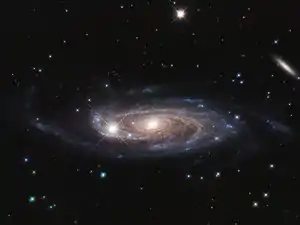UGC 2885
UGC 2885 (Rubin's Galaxy,[10] nicknamed "Godzilla galaxy"[11]) is a large barred spiral galaxy of type SA(rs)c in the constellation Perseus. It is 232 million light-years (71 Mpc) from Earth and measures 463,000 ly (142,000 pc) across, making it one of the largest known spiral galaxies.[8][4] It is also a possible member of the Pisces-Perseus supercluster.[12]
| UGC 2885 | |
|---|---|
 UGC 2885 by Hubble Space Telescope.[1] | |
| Observation data (J2000 epoch) | |
| Constellation | Perseus |
| Right ascension | 03h 53m 02.458s[2] |
| Declination | +35° 35′ 22.17″[2] |
| Redshift | 0.019353[3] |
| Distance | 71.1 Mpc (232 Mly)[4] |
| Apparent magnitude (V) | 13.5[5] |
| Characteristics | |
| Type | SA(rs)c[5] |
| Mass | 2 trillion[6][7] M☉ |
| Size | 463 kly (142 kpc)[8] |
| Apparent size (V) | 3.9′ × 1.9′[5] |
| Other designations | |
| IRAS 03497+3526, MCG+06-09-012, TC 49, Z 039.8+3527[9] | |
UGC 2885 is a spiral galaxy with a relatively low surface brightness. The central bulge is the most prominent feature of this galaxy, where a faint bar crosses its center.
UGC 2885 is classified as a field galaxy—a class of galaxies found in remote, under-dense and “vacant” sections of space, far from other major galaxies. NASA has reported that the theorized main source for disk growth for UGC 2885 came from the accretion of intergalactic hydrogen gas, rather than through the repeated process of galactic collision, as most galaxies are thought to grow.
The lack of interaction is evident from the near-perfect structure of the spiral arms and disk, lack of tidal tails, and modest rate of star formation—approximately 0.5 solar masses/year.
Additionally, despite being originally classified as an unbarred spiral galaxy, new Hubble images clearly show the presence of a small bar cutting across the ring structure of the core. This is peculiar, as most bars are thought to form through minor gravitational perturbations brought on by satellite and neighboring galaxies, which is something this galaxy lacks. This galaxy highlights that bars are able to form in spiral galaxies without the influence of another galaxy—this indicates that other forces, such as interactions between stars, gas and dust, as well as the gravitational influence of dark matter, might play a role in their development.
On 17 January 2002, the explosion of a type II supernova was detected as SN 2002F.[13][14]
See also
- IC 1101
- NGC 6872 and IC 4970, mistakenly claimed to be the largest spiral galaxy as of 2013
- Malin 1, the largest known spiral galaxy
- NGC 262
References
- "Hubble Surveys Gigantic Galaxy". www.spacetelescope.org. Retrieved 6 January 2020.
- Brown, A. G. A.; et al. (Gaia collaboration) (August 2018). "Gaia Data Release 2: Summary of the contents and survey properties". Astronomy & Astrophysics. 616. A1. arXiv:1804.09365. Bibcode:2018A&A...616A...1G. doi:10.1051/0004-6361/201833051. Gaia DR2 record for this source at VizieR.
- Canzian, Blaise; Allen, R. J.; Tilanus, R. P. J. (1993). "Spiral structure of the giant galaxy UGC 2885 - H-alpha kinematics". The Astrophysical Journal. 406: 457. Bibcode:1993ApJ...406..457C. doi:10.1086/172457.
- Tully, R. Brent; Courtois, Hélène M.; Sorce, Jenny G. (2016). "Cosmicflows-3". The Astronomical Journal. 152 (2): 50. arXiv:1605.01765. Bibcode:2016AJ....152...50T. doi:10.3847/0004-6256/152/2/50.
- NASA/IPAC Extragalactic Database. "NED search results for object UGC 02885". Retrieved 2013-09-05.
- Jeremy Heyl (1980). UGC 2885, the Largest Known Spiral Galaxy (PDF). The University of British Columbia.
- "UGC 2885 - GIANT SIZE Spiral Galaxy". Retrieved 2016-05-17.
- Hunter, Deidre A.; Elmegreen, Bruce G.; Rubin, Vera C.; Ashburn, Allison; Wright, Teresa; Józsa, Gyula I. G.; Struve, Christian (2013). "Star Formation in Two Luminous Spiral Galaxies". The Astronomical Journal. 146 (4): 92. arXiv:1307.7116. Bibcode:2013AJ....146...92H. doi:10.1088/0004-6256/146/4/92. S2CID 119195964.
- "UGC 2885". SIMBAD. Centre de données astronomiques de Strasbourg.
- https://apod.nasa.gov/apod/ap200125.html
- https://www.nasa.gov/feature/goddard/2020/nasas-hubble-surveys-gigantic-galaxy
- "UGC 2885 by jshuder". Retrieved 2018-05-17.
- "UGC 2885, Spiral Galaxy; Supernova 2002 F". Retrieved 2016-05-17.
- "SN 2002F". Retrieved 2018-05-17.